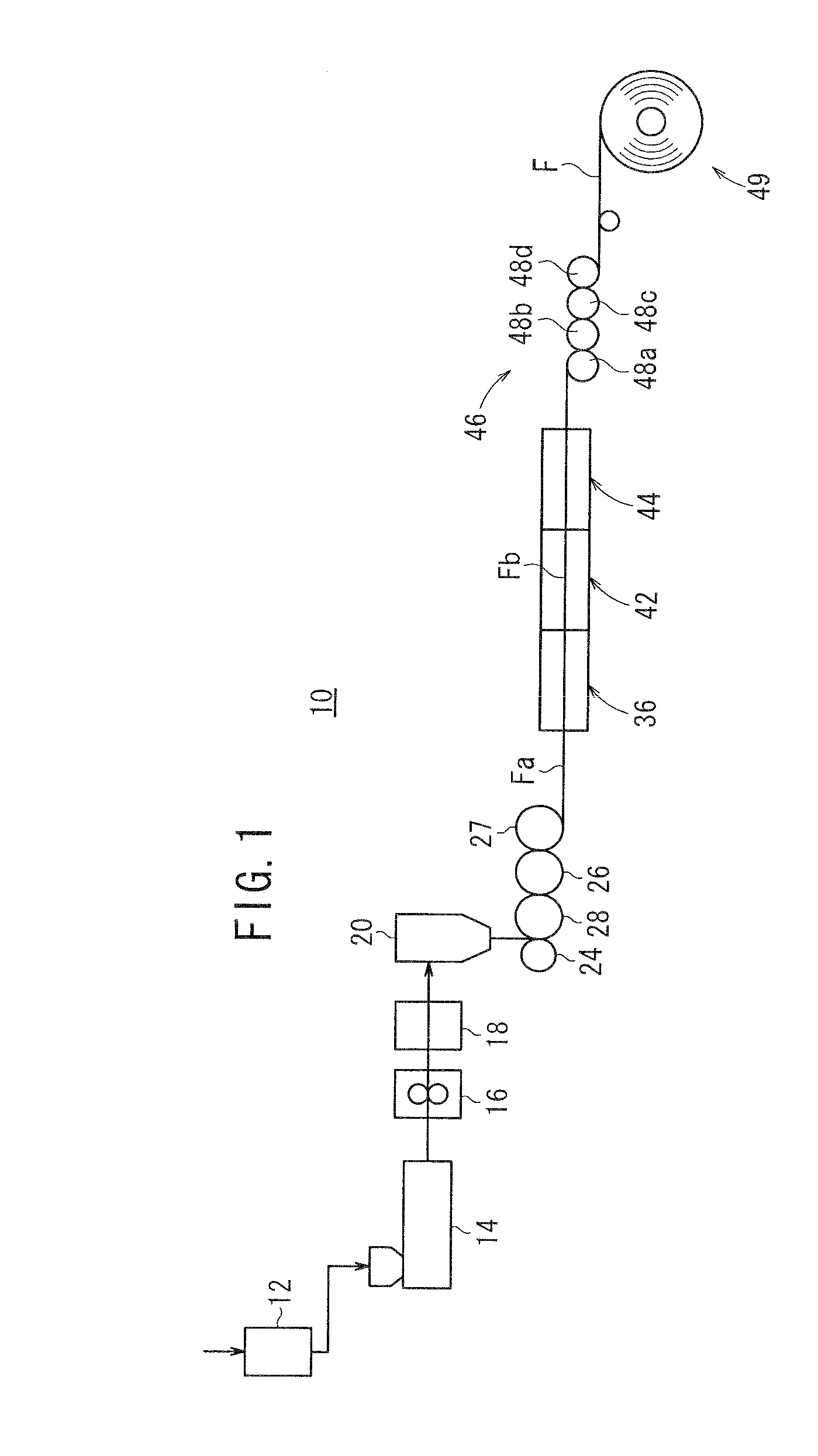[0032]The film producing apparatus 10 shown in FIG. 1 is capable of producing a thermoplastic film F useful for a liquid
crystal display device, etc. A pellet of a material for the thermoplastic film F, such as a
cellulose acylate resin, a cycloolefin resin, a
polycarbonate resin, or a
lactone ring-containing
polymer resin, is introduced to a dryer 12, and dried therein. The dried pellet is extruded by an extruder 14, and transported to a filter 18 by a
gear pump 16. A contaminant in the pellet is removed by
filtration with the filter 18, and a resin melt of the thermoplastic resin is extruded from a die 20. Then, the resin melt is press-formed between a first
casting roll 28 and a touch roll 24, and cooled and solidified on the first
casting roll 28 to prepare a film-shaped melt having a predetermined
surface roughness. The film-shaped melt is transported by a second
casting roll 26 and a third casting roll 27, to obtain an unstretched film Fa. The unstretched film Fa may be then wound and removed. Alternatively, the unstretched film Fa may be successively introduced to a transverse stretching portion 42 for long-span stretching. Even in a case where the unstretched film Fa is once wound and removed, and then introduced to the transverse stretching portion 42, the advantageous effects of the present invention are achieved.
[0033]In the transverse stretching portion 42, as shown in FIG. 1, the unstretched film Fa is stretched in the width direction perpendicular to the transporting direction to prepare a transversely stretched film Fb. A preheating portion 36 and a heat-fixing portion 44 may be disposed upstream and downstream of the transverse stretching portion 42 respectively to reduce bowing (misalignment of the optic axes) in the stretching process. The preheating temperature is preferably higher than the transverse stretching temperature, and the heat-fixing temperature is preferably lower than the transverse stretching temperature. The bowing is generally such that the width direction center of the film is concave forward in the transporting direction. When the above temperatures satisfy the conditions of [preheating temperature>stretching temperature] and [stretching temperature>afterheating temperature], the bowing can be reduced. One or both of the preheating and afterheating treatments may be carried out.
[0034]After the transverse stretching, the transversely stretched film Fb is heat-treated and shrunk in the longitudinal direction in a heat-treating zone 46. As shown in FIG. 2, the side edges of the film Fb are not fixed by a chuck, and the transversely stretched film Fb is transported by a plurality of rolls 48a to 48d such that the transversely stretched film Fb is shrunk not in the TD (transverse direction) but in the MD (longitudinal direction). As shown in FIG. 3, the rolls 48a to 48d are arranged such that the ratio (G / D) of the inter-roll distance (G) to the roll lap length (D) is 0.01 to 3. As a result, transverse shrinkage of the transversely stretched film Fb is prevented due to the friction between the film and the rolls. The transversely stretched film Fb is transported in the heat-treating zone 46 at a transporting speed (V1) of the entry-side roll 48a and at a transporting speed (V2) of the exit-side roll 48d such that the ratio (V2 / V1) of the exit-side transporting speed (V2) to the entry-side transporting speed (V1) is 0.6 to 0.999. Thus, the transversely stretched film Fb is longitudinally shrunk in the heat-treating zone 46.
[0035]The transversely stretched film Fb is heat-treated in the heat-treating zone, so that a thermoplastic film F having controlled orientation angle and retardations is produced as a final product. The film F is wound in a winding portion 49.
[0036]A longitudinal stretching process may be carried out before or after the transverse stretching process. The film may be longitudinally stretched such that the film is transported between a pair of nip rolls, the transporting speed of the exit-side nip roll being higher than that of the entry-side nip roll. A longitudinal stretching method may be selected depending on the ratio (L / W) of the distance L between the nip rolls to the film width W at the entry-side nip roll. When the L / W ratio is small, a longitudinal stretching method described in Japanese Laid-Open Patent Publication Nos. 2005-330411 and 2006-348114, etc. may be used. In this method, the size of a stretching
machine can be reduced though the Rth of the film is often increased excessively. On the other hand, when the L / W ratio is large, a longitudinal stretching method described in Japanese Laid-Open Patent Publication No. 2005-301225, etc. may be used. In this method, the Rth of the film can be reduced though the size of a stretching
machine is often increased.
[0037]FIG. 4 is a
schematic structural view showing a liquid
crystal display device 50 using the thermoplastic film F produced in the above manner.
 Login to View More
Login to View More 


